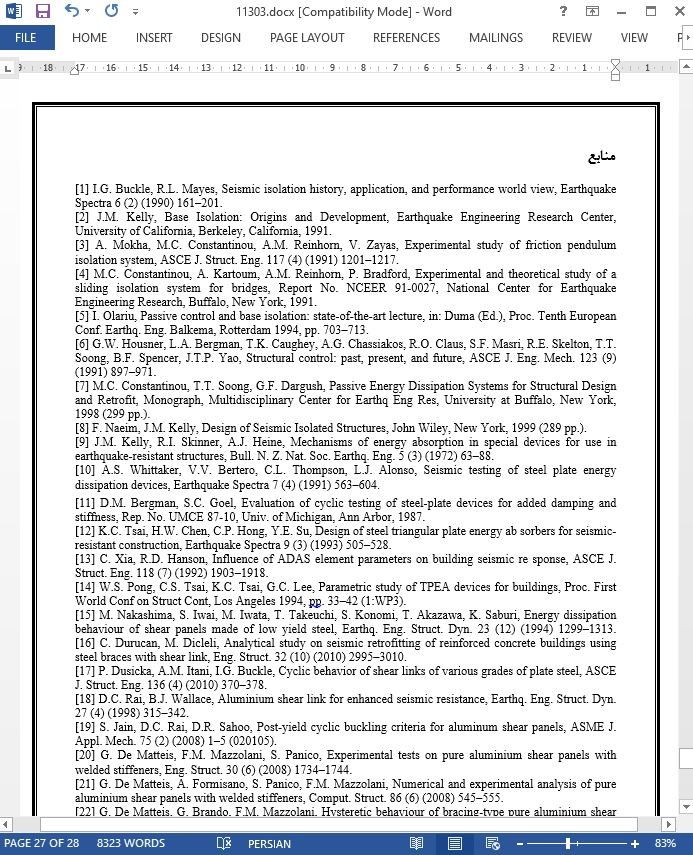
رفتار تناوبی تسلیم برشی و خمشی میراگر فلزی
چکیده
پتانسیل استهلاک انرژی یک میراگر فلزی تا حد زیادی به پاسخ هیسترتیک به دست آمده ناشی از تغییر شکل غیر ارتجاعی صفحات در حالت های بارگذاری محوری، خمشی و یا برشی بستگی دارد.در این مطالعه، یک دستگاه استهلاک انرژی منفعل متشکل از یک سری صفحات فولادی که توانایی تسلیم برشی و خمشی داشتند، تحت بار گذاری دوره ای در آزمایشگاه قرار گرفته و بررسی شدند. دو صفحه ی پایانی با پیکربندی X مجاز به تسلیم شدن تحت عملکرد خمشی شدند، در حالی که صفحه مستطیل شکل بال دستگاه، مجاز به استهلاک انرژی از طریق تسلیم شدن برشی است. سه مقدار از تسلیم برشی و خمشی دستگاههای میراگر (SAFYD) بر اساس تغییر اندازه صفحات خمشی و برشی مورد مطالعه قرار گرفت. پارامترهای اصلی مورد مطالعه عبارتند از: ظرفیت تحمل بار، پاسخ هیسترتیک، استهلاک انرژی، میرایی ویسکوز معادل، و انعطاف پذیری. تجزیه و تحلیل المان محدود به منظور پیش بینی مقاومت نهایی و پاسخ هیسترتیک نمونه آزمایش انجام شده است. نتایج آزمایش به خوبی با نتایج پیش بینی شده همخوانی دارد. در نهایت، یک روش طراحی شده که با توجه به میزان بار جانبی داده شده، نسبت صفحات خمشی و برشی دستگاه های SAFYD را ارائه می دهد.
1. مقدمه
روش معمول استهلاک انرژی در یک ساختمان بدین منظور است که اجازه ی ایجاد خسارتهای سازه ای موضعی (به عنوان مثال، مفصل پلاستیک) در عناصر مقاوم در برابر بارگزاری جانبی اولیه بدهد. این عناصر آسیب دیده، نیاز به جایگزینی کامل یا اصلاح گسترده در سناریوی بعد از زلزله دارد تا به مقاومت جانبی ، سختی جانبی، تغییر شکل، و استهلاک یا حذف انرژی اولیه ی خود برسد. تعدادی از تکنیک های نوآورانه، به منظور بهبود عملکرد سازه ها، با به حداقل رساندن خسارتها در بارگزاری اولیه، در عناصر مقاوم در برابر زلزله، توسعه یافته اند. معمولا، استفاده از جداساز لرزه ای در فونداسیون یک ساختمان یکی از تکنیک های مورد استفاده برای افزایش انعطاف پذیری سازه می باشد که منعکس کننده بخش عمده ای از انرژی زلزله است[1-4]. تکنیک های مدرن کنترل پاسخ لرزه ای شامل نصب و راه اندازی دستگاههای مکمل استهلاک یا جذب انرژی در سازه ها می باشد. هدف اولیه اضافه کردن این دستگاه های مکمل به یک ساختمان، استهلاک انرژی لرزه ای از طریق رفتار هیسترتیک به وسیله ی عناصر خاص طراحی شده و جلوگیری از خسارت موضعی در عناصر مقاوم ساختمان در برابر بارگزاری اولیه است.
7. نتیجه گیری
نتایج زیر را می توان از این تحقیق بدست آورد:
• ترکیب تسلیم ورق های خمشی و برشی در میراگرهای فلزی به مقدار قابل توجهی پتانسیل ظرفیت بابری جانبی و اتلاف انرژی را در مقایسه با میراگرهای ADAS و دستگاه های انصال برشی افزایش می دهد. در میزان یکسانی از مقاومت جانبی و اتلاف انرژی، دستگاه های SAFYD می توانند به میزان قابل توجهی باعث صرفه جویی در مصالح و هزینه شوند.
Abstract
The energy dissipation potential of a metallic damper largely depends on the hysteretic response achieved due to the inelastic deformation of plates under either axial or flexural or shear loading. In this study, a passive energy dissipation device consisting of a series of steel plates capable of yielding in both flexure and shear has been experimentally investigated under cyclic loading. Two end plates of X-configuration are allowed to yield under flexural action, whereas a rectangular web plate of the device is allowed to dissipate energy through shear yielding. Three shear-and-flexural yielding damping (SAFYD) devices are studied by varying the size of both flexure and shear plates. The main parameters investigated are load-carrying capacity, hysteretic response, energy dissipation, equivalent viscous damping, and ductility. A finite element analysis has been carried out to predict the ultimate resistance and hysteretic response of the test specimen. The predicted results matched reasonably well with the test results. Finally, a design procedure has been proposed to proportion the flexure and shear plates of SAFYD devices for a given lateral load demand.
1. Introduction
Conventional approach of energy dissipation in a structure is to allow the localized structural damages (i.e., plastic hinges) in the primary lateral load-resisting elements. These damaged elements require either complete replacement or extensive modification in the postearthquake scenario in order to restore their lateral strength, lateral stiffness, deformability, and energy dissipation/absorption mechanism. A number of innovative techniques have been developed to improve the performance of structures subjected to earthquake excitations by minimizing the damages in the primary load-resisting elements. Traditionally, seismic isolation at the foundation level of a structure is one of the techniques used to increase the structural flexibility, thereby, reflecting a major portion of the earthquake energy [1–4]. The modern techniques of controlling seismic response involve the installation of supplemental energy dissipating/absorbing devices in the structures. The primary aim of adding these supplemental devices in a structure is to dissipate the seismic energy through the hysteretic behavior of specially designed elements and to avoid the localized damages in the primary load-resisting structural elements.
7. Conclusions
The following conclusions can be drawn from the present study:
• The combination of shear and flexural yielding of plates in metallic dampers significantly increases the lateral load carrying capacity and the energy dissipation potential as compared to the ADAS and shear link devices. A considerable saving in materials and cost can be achieved in the case of SAFYD devices for the same level of lateral strength and energy dissipation.
چکیده
1. مقدمه
2. اهداف این مطالعه
3. ایده اصلی و طراحی میراگر با تسلیم ترکیبی
4. مطالعه آزمایشی
4 . 1 . نمونه های آزمایشی
4 .2 . ساخت نمونه ها
4 .3 . چینش برای تست
4 .4 . ابزار و سنسورها
4 .5 . روند جابجایی ها
4 .6 . ویژگی های مواد
5. نتایج آزمایش
5 .1 . پاسخ هیسترتیک
5 .2. مقاومت جانبی:
5 .3. استهلاک انرژی و میرایی
5 .4. چگونگی و میزان کرنش
5 .5. مکانیزم تسلیم و رفتار اتصالات
6. بحث
6 .1. پیش بینی تحلیلی پاسخ سیکلی
6 .2. مقایسه نتایج آزمایش با مقادیر طراحی
7. نتیجه گیری
Abstract
1. Introduction
2. Objectives of this study
3. Concept and design of combined yielding damper
4. Experimental study
4.1. Test specimens
4.2. Fabrication of specimens
4.3. Test set-up
4.4. Instrumentations and sensors
4.5. Displacement history
4.6. Material properties
5. Test results
5.1. Hysteretic response
5.2. Lateral strength
5.3. Energy dissipation and damping
5.4. State of strain
5.5. Yield mechanism and connection behavior
6. Discussion
6.1. Analytical prediction of cyclic response
6.2. Comparison of experimental results with design values
7. Conclusions
- اصل مقاله انگلیسی با فرمت ورد (word) با قابلیت ویرایش
- ترجمه فارسی مقاله با فرمت ورد (word) با قابلیت ویرایش، بدون آرم سایت ای ترجمه
- ترجمه فارسی مقاله با فرمت pdf، بدون آرم سایت ای ترجمه



